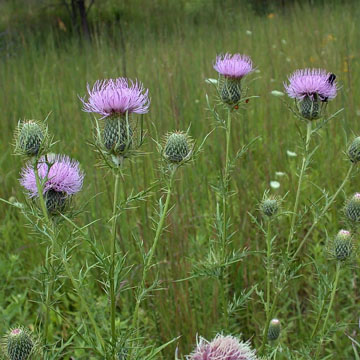

Cirsium discolor - (image 1 of 4)
Taxonomy
Family: Asteraceae
Habitat
Fields, meadows, roadsides, open woods, mostly in disturbed areas.
Associates
Distribution
Southern Quebec and Ontario to MN and adjacent Manitoba, south to NC, MS, LA, and KS.
Morphology
Fibrous-rooted perennial or biennial; stem 1-2 m, openly branched, spreading hirsute to subglabrate, sometimes slightly tomentose in the inflorescence; leaves deeply pinnatifid, firm, spiny, broadly oblanceolate to obovate or elliptic, densely white-tomentose beneath, scabrous-hirsute to subglabrous above; heads several or numerous on leafy peduncles; involucre rather broad based; middle and outer bracts tipped with a spine 2-5 mm; inner bracts attenuate or often with a scarious, slightly dilated and erose tip; flowers pink-purple; achenes 4.5-6 mm.
Notes
Flowers July to October
Wetland indicator: UPL
Grows to about a meter in height in sandy soil but can be much taller in rich soil. Like other native thistles this species is great for attracting pollinators. Cirsium altissimum is similar but often taller with more narrower involucres and leaves toothed or shallowly lobed but not deeply pinnatifid.
References
Gleason, Henry A. and A. Cronquist. 1991. Manual of Vascular Plants of
Northeastern United States and Adjacent Canada. Second Ed.
The New York Botanical Garden. Bronx, NY
|
Michael Hough © 2018 |